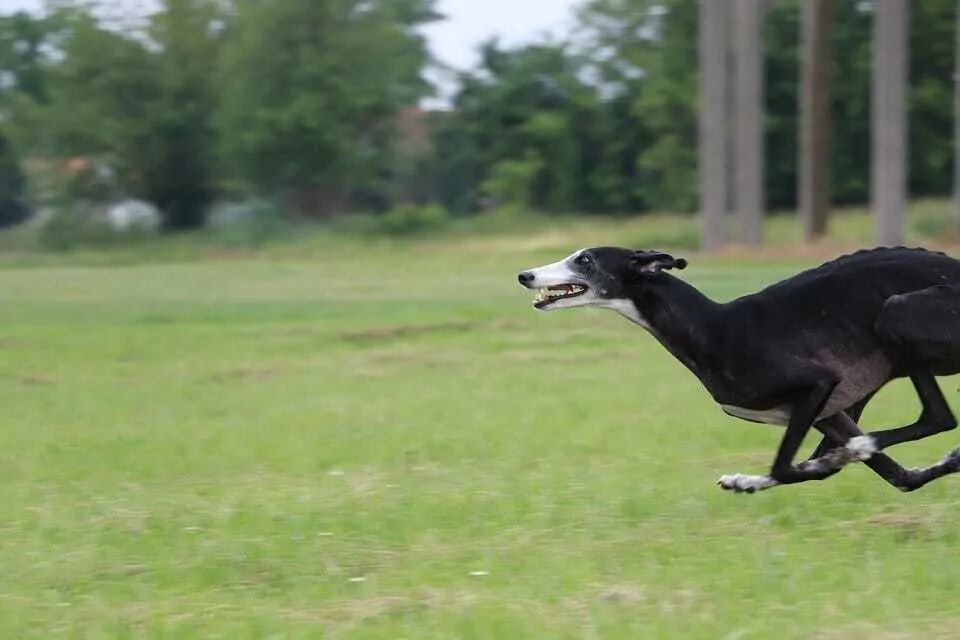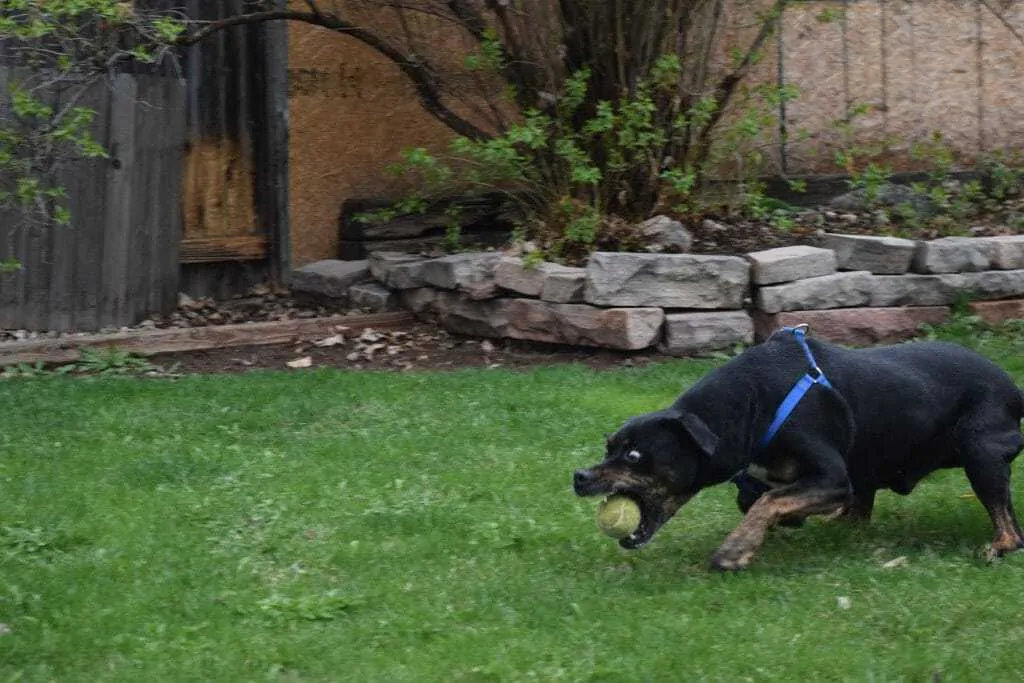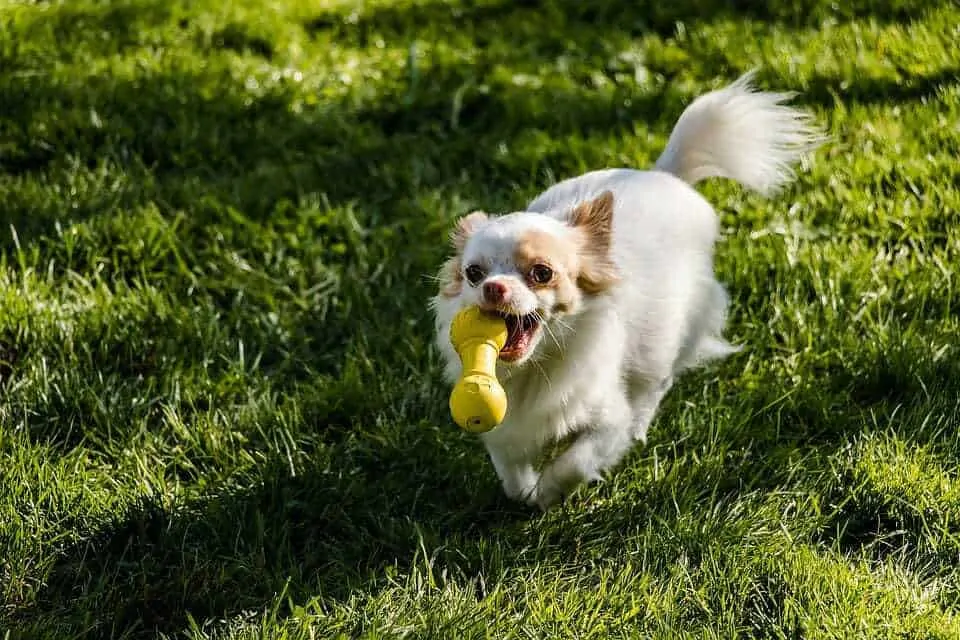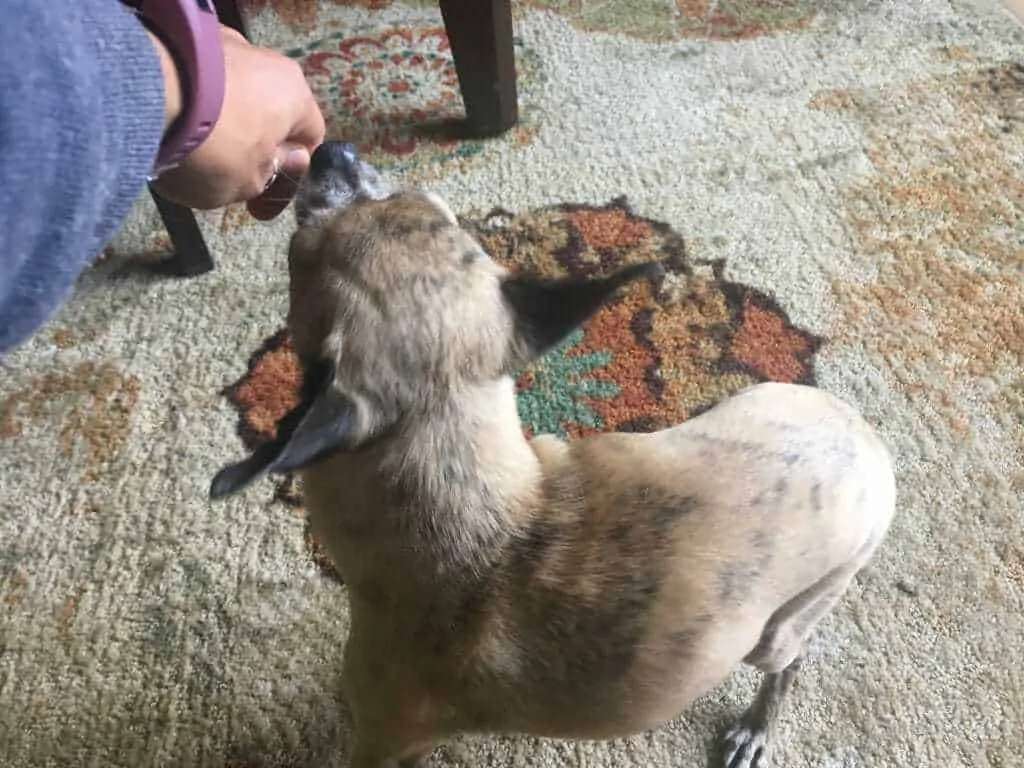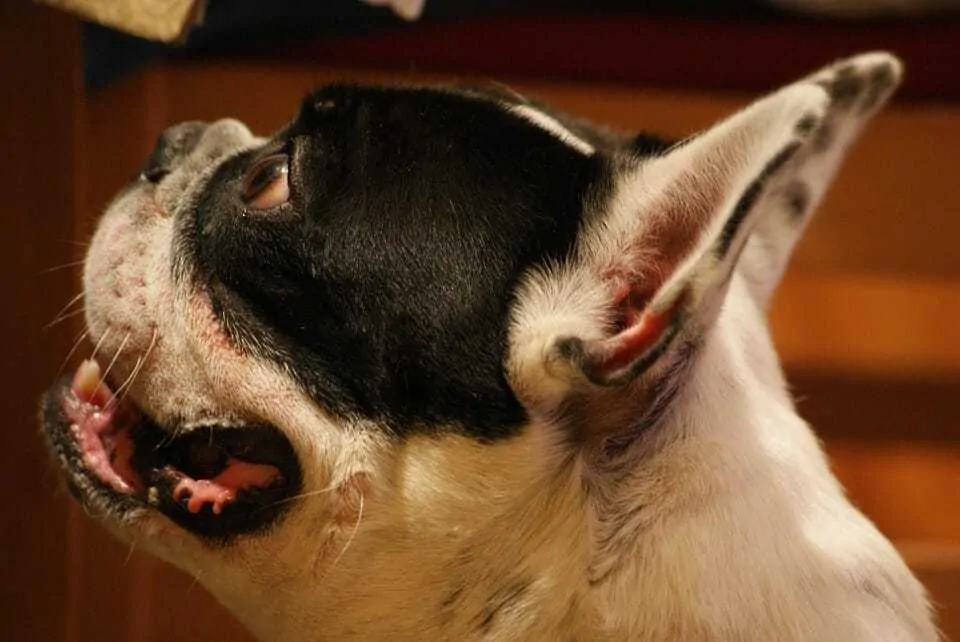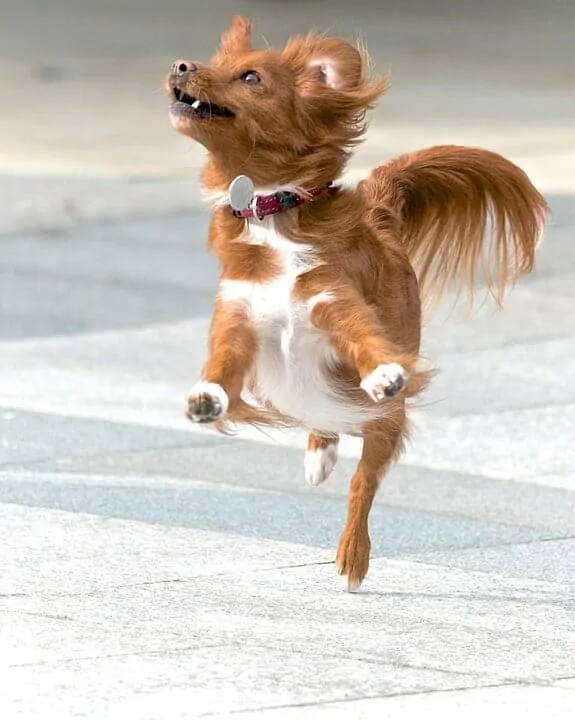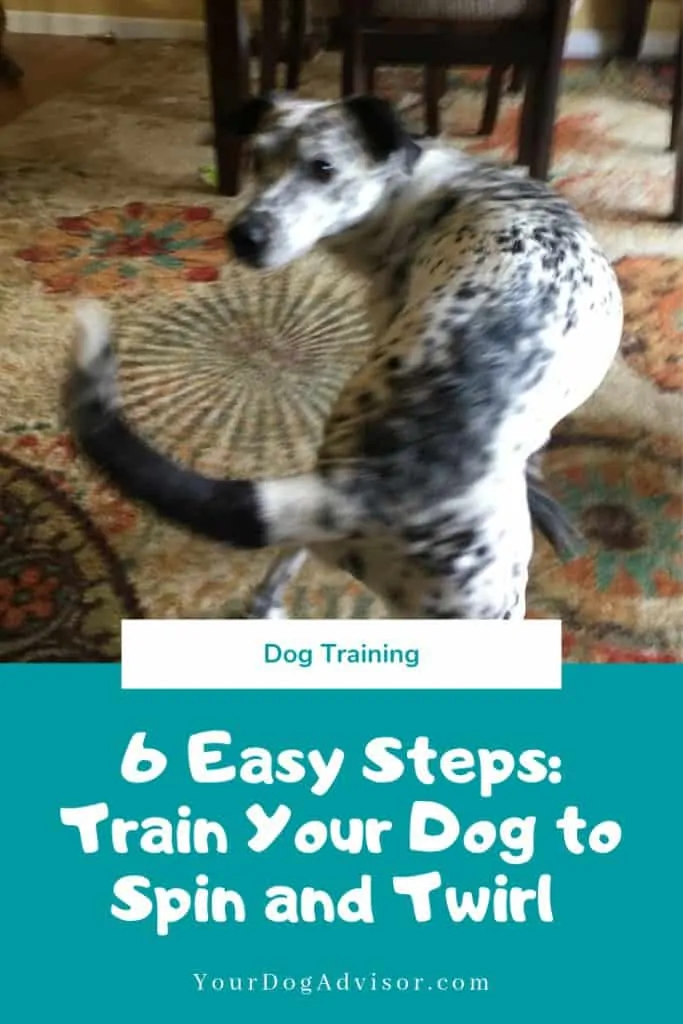Are you looking for a fun and exciting new trick to teach your dog? Do you want something flashy that doesn’t take a lot of technical training knowledge or expert timing skills?
Even the most novice of trainers can easily teach their dog to spin in a circle on command. And once you know how to teach a spin, turning it around and teaching your dog to twirl in the opposite direction is a snap. What better way to kickstart your dog’s trick training catalog than with a two for one behavior?
Unlike many other “simple-looking” tricks, spin doesn’t require perfect timing or any advanced skills like shaping or catching. In fact, all you need to teach your dog how to spin is a quick lesson in something called “luring.”
>>>Looking for a more complex trick to teach your dog? Try the place command.
Contents
Creating an Effective Lure
Whether you are training for obedience-centered commands like sit and stay or fun tricks like roll over and wave, luring is one of the most common methods of getting dogs to perform different behaviors. However, if you are new to positive reinforcement training or new to training altogether, you may not be familiar with what a lure is.
Think of luring as greyhound coursing, just in a much more condensed form. Your hand is the fake rabbit that needs to move in a way that will get your dog to walk, jump, spin, or roll in the exact way you want them to.
In more traditional, outdated forms of training, dogs were forced to perform certain behaviors through a few different techniques. The most common was body manipulation. One simple example of this would be pushing on the dog’s bum to get them to sit.
Negative punishment is another way trainers used to get their dogs to do what they wanted. If the trainer wanted the dog to heel, for instance, they would use a choke chain and leash to make the dog uncomfortable any time they were out of position. The only way to escape that discomfort was to walk by the handler’s side.
These same behaviors can easily be accomplished through a much simpler, more positive way of training known as luring. And because luring doesn’t cause anxiety or pain, it allows dogs to learn behaviors much more quickly and perform them more reliably in the future. And since the dogs have to complete the movements themselves instead of being manipulated into different positions, they are more likely to connect the behavior with the command.
Luring involves using a treat or toy to entice your dog into different positions, much like using a carrot to lure a horse into their stall. While the concept itself is very simple, creating an effective lure does take a little knowledge and practice.
Keep Your Dog Interested
The perfect lure involves pulling your dog along by the nose using a high-value reward that they want to follow. Of course, they aren’t following the reward just for fun, they are following it because they want to eat or play with it.
Some dogs are highly motivated by toys while others only care about treats. Play with different items to see which will work the best for luring your dog.
If you are constantly pulling the lure out of your dog’s reach, they are likely to quickly give up on following it. Since you can’t lure your dog with something they won’t follow, you have to keep them interested in the reward. There are two key ways you can accomplish this.
First, make sure you choose a treat or toy that your dog gets very excited about.
Consider this: Your friend offers you a piece of gum. When you reach for it, they snap their hand back and laugh. What do you do? You probably give them a dirty look and walk away without the gum. But what if your friend offered you tickets to see your favorite band in concert, and then snapped their hand back when you reached for them. What would you do? Keep trying to get them, probably. Maybe even tackle your friend and pry them out of their hands.
That’s close to the reaction you want your dog to have when you present them with the lure.
The second way to keep your dog interested is to keep your lures short and reward your dog frequently by giving them the treat or letting them play with the toy. This not only keeps your dog from thinking you are just tricking them, but it also keeps them motivated to keep training.
If you are teaching your dog to walk nicely on leash, for instance, instead of luring them to walk by your side the full length of the room and then rewarding them, reward them every few feet. As they get the hang of the behavior, slowly increase the distance between rewards.
Don’t Let Your Dog Get Hyper-Focused
While an enticing lure is key, at the same time, you don’t want your dog to become too focused on it. If all your dog can think is, “Oh man, oh man, I need to get that treat, I need it right NOW!” then they are going to struggle to learn whatever you are trying to train them. You may be able to lure them into position, but if all they are thinking about is the lure, they probably didn’t even notice they moved.
There is such a thing as being too ball motivated. If your dog loses their mind every time you break out the tennis ball or the hot dogs, find something a little less valuable to use during training.
If your dog is constantly trying to chew the lure out of your hand or jumping on your arm to get control of it, you may need a slightly less valuable lure. Play with different types of treats and toys. You may even want to use different types of lures for harder behaviors and easier ones.
If your dog is right on top of your lure, you may also need to move your hand faster or hold it slightly above or below their mouth to create a tiny bit of distance. This will help them stay more aware of their own movements and should increase how quickly they pick up new behaviors.
How to Remove a Lure
Just when you get your lure down for a new behavior, it’s usually time to get rid of it. As frustrating as that is, it is an important step to getting your dog to complete a behavior from a simple cue rather than exaggerated hand movements. Unfortunately, this can be one of the most difficult pieces of lure training.
Timing is Everything
The first step to successfully removing your lure from the new behavior is to pinpoint the right time to start removing it.
If you remove the lure too early, your dog is going to get confused and start offering rough approximations of the behavior you want. Removing the lure too early on your dog’s roll over is likely to lead to a dog that lays down and puts their head awkwardly on the floor and then jumps up looking for a treat.
Pay attention to your dog as you train. Are they completing the behavior because they understand what you are asking? Or are they just following your lure? Use the lure as long as your pup needs it, but fade it out as soon as they are ready.
If you remove it too late, not only have you wasted some prime training time, but your dog may become too reliant on the lure.
The best time to start removing the lure is when your dog seems to be anticipating the behavior. They might show this by moving faster than the lure, or by focusing less on it. For instance, if you are teaching your dog to sit and suddenly they are plopping their bum down as soon as you start to lift your hand up, they are ready to say goodbye to the lure.
Fading Your Lure
There are a few different techniques you can use to get rid of or “fade” a lure. You may find that some work better for your dog on certain tricks or that you need to use multiple techniques on one behavior. You won’t know exactly what’s right for your dog until you try different methods.
In many cases, you might find that running through the full lure, but doing it quicker will help reduce your dog’s need for the lure. If you are working on roll over and your dog is ready, you might quickly drop your hand to the ground to get them to down, wait for them to catch up, then quickly circle your hand over their head to get them to roll.
Your dog won’t be able to follow the lure the whole time, but it will provide enough of a guide to get them moving in the right direction. As they are able to do more and more of the trick by themselves, you can complete the lure quicker and quicker.
Luring may sound complicated, but with a little practice, just about anyone can do it successfully.
You can also try removing the end of the lure and letting your dog complete the behavior on their own. If you are teaching your dog down, for instance, you would bring the lure to their nose as they sit and begin dropping your hand to the ground, but stop short of pulling your dog into a down. With each repetition, you can remove more and more of the lure until you are hardly moving your hand at all.
For some behaviors, the best way to fade the lure is to just stop doing it all at once. This doesn’t work in all situations but can be effective in the right ones. For instance, you might find that your dog gets overly focused on the lure during the training for spin. If that happens, it can be very difficult to fade the lure because your dog will try to follow it no matter how fast it goes or when it stops. That can result in half spins or spins that start in one direction and end going the other.
In a case like this, you may want to simply present your dog with a reward then stand there ignoring them until they offer the behavior you want. It may take a few minutes for them to offer the right one, but, since they were just being rewarded for it, they should eventually give it a shot.
>>>Trick training is a great way to stimulate a high energy dog. Here are more great tips for surviving a hyper pup.
Teach Your Dog to Spin and Twirl
Now that you know how to create and fade a lure, it’s time to put that knowledge to the test. Grab your dog’s preferred luring treats or toy (or a few different options of both), your treat bag if needed, and find a quiet room in your house to get started.
If you are using a toy to lure your dog, make sure you give them time to play with it each time they complete the trick. If you only let them have it for a few seconds before taking it back, they are going to get frustrated and stop performing.
Step 1: Pick your direction
The first behavior we are going to teach is the one we will call “spin.” You will need to decide which direction your dog is going to turn for spin. We will call a turn in the opposite direction “twirl.” For the sake of these steps, spin will be a clockwise turn and twirl will be a counterclockwise turn.
If you’ve attempted to train this before and know your dog has a preference for turning one way over the other, choose that direction to train first.
Step 2: Lure your dog in a wide circle
With your dog standing in front of you, take your tasty treat (or toy) and hold it right in front of your dog’s nose.
With your hand parallel to the ground, move it in a large circle clockwise from your dog’s nose and back to where you started.
TIP: If you have a large dog, you will need to create a larger circle than if you have a small dog. Make sure your dog has room to turn around. If your dog stops following the lure halfway through and turns to get it from the other direction, you probably need to create a larger circle so they can turn all the way around.
Once your dog turns fully around and is facing you again, reward them with the treat (or toy) and give them lots of praise.
You may need to let your dog lick or bite at the treat as you start the lure, but once they are moving, try to keep your hand about an inch in front of their face.
Repeat this process over and over until you notice your dog anticipating the movement you are trying to get. Remember, dogs learn best with lots of repetition, so expect to have to go through this process a few dozen times.
Step 3: Fade your lure into a hand cue
Once your dog has shown they are ready to fade the lure by either turning faster than the lure or by focusing more on their movement than on your hand, you are ready to get rid of the lure.
You can try any of the lure fading techniques above, but the one that typically works the best for this trick is to speed up your lure.
Start as you did before with your dog standing in front of you. Take your lure hand and slowly move it in a clockwise circle, as your dog starts to pivot, increase the speed of the lure. If at any point they stop turning, slow the lure back down and wait for them to catch up.
Your dog has been so focused on the lure that suddenly removing it will only confuse them. Make sure to fade the lure slowly to allow your dog time to figure out how to fill in the gaps themselves.
Reward and praise your dog when they finish.
TIP: If at any point your dog fails to complete the full spin, just get them back into starting position and try again. You may need to slow your lure back down for a few reps before you try to fade it again.
Repeat this process, increasing the speed of the lure with each successful rep. You should notice your lure creates a smaller and smaller circle as you speed it up. Keep creating a smaller, faster circle with your lure until you are only moving your wrist in a circle above your dog’s head. This is your new hand cue for spin.
In this video, you will see how to lure your dog in a circle, fade your lure into a hand cue, and then add a verbal cue.
Step 4: Add your verbal cue
Once your dog has successfully completed a few reps with just the hand cue, you are ready to name this behavior.
On the next rep, before giving your hand cue, say “spin!”. Then give your hand cue and praise and reward your dog when they complete the turn.
Repeat this process over and over so your dog has a chance to build an association between the new cue and the behavior they are already doing. The average dog needs about forty reps to build this connection, so be prepared to spend some time on this step.
Step 5: Give your dog time to master the behavior
Once your dog can perform the spin behavior with just a simple hand and verbal cue, you will need to give them a few days to master the behavior.
Try asking them for a spin before you put down their dinner bowl or before you throw them the ball. Randomly pull out a handful of treats and ask for a few spins in a row.
You want your dog to be confident in this behavior before you teach them how to turn in the opposite direction so they don’t confuse the two commands.
After a few days, assuming your dog happily performed their spin on cue just about every time, you are ready to teach them twirl.
Now that your dog has mastered the clockwise turn, it’s time to train them to spin the opposite way!
Step 6: Reverse and reteach the behavior
You will use the same steps as those above to teach twirl, except this time, lead your dog in a counterclockwise circle.
As you fade the lure, you will see that your hand cue for twirl is a quick wrist spin in the opposite direction of the cue for spin.
Once you are ready to add a verbal cue for the behavior, use the word “twirl.” Just as you did with spin, make sure to give your dog a few days to master the twirl behavior before you reintroduce spin.
>>>Looking for another fun trick to teach your dog? Sit pretty can be taught in just five easy steps.
Keep It Straight and Let Them Whirl
Once your dog has mastered twirl, it’s time to test their understanding of these two similar behaviors. Ask your dog to spin then twirl back to back. If your dog spins in the wrong direction, don’t reward them. Ask again and only treat them when they spin the right way.
The more energetic you are during training, the more exciting your dog’s end behavior will be. If you want your dog to leap or stand as they spin, use an exciting tone and lots of energy to get them to spin faster.
Giving the commands back to back (and in the opposite order) will help them learn to differentiate between the two commands.
Of course, it’s just as important that you remember which is which, too. Make sure you are giving the right hand cue with each verbal cue. If you find your dog turning in the wrong direction frequently, it may just be you who is getting it wrong!

Sara Seitz has spent most of her life in the pet industry and has a bachelors in animal behavior from Colorado State University. Sara started working with dogs and cats as a high schooler at a rural boarding kennel. There she learned a lot about the bad and the ugly of the pet service industry. But not even the toughest day at that job would dissuade Sara from following her dream of working with animals.
In college, Sara got a job at a dog daycare and boarding facility in Fort Collins, Colorado. Her new career provided even more opportunities for learning about dog behavior than her classes did. As general manager of the daycare, Sara helped the company launch a new in-home pet sitting branch and trained to become a certified dog trainer. Between shifts taking care of peoples pets in-home and supervising dogs during playtime at the daycare, Sara organized and taught obedience classes.
Sara has always been passionate about bettering the lives of our canine companions. She soon found that advocating for and educating owners in the power of positive reinforcement training was one of the best ways to help dogs and their owners live happier lives.
